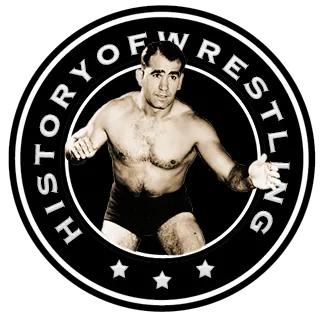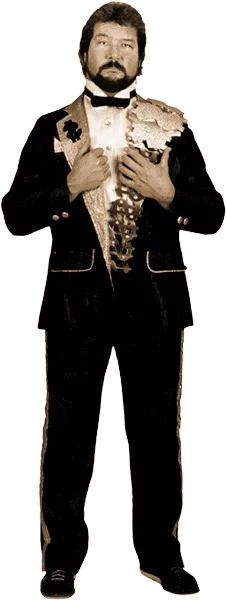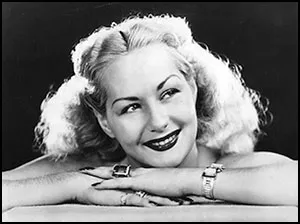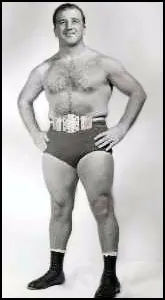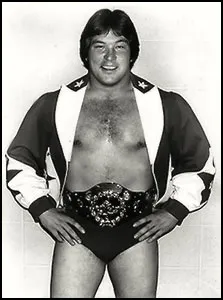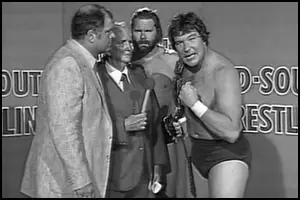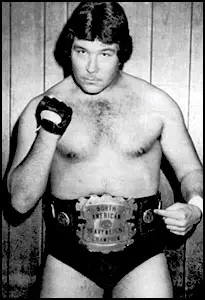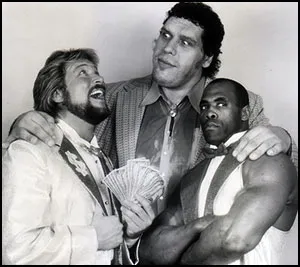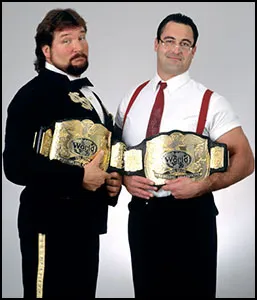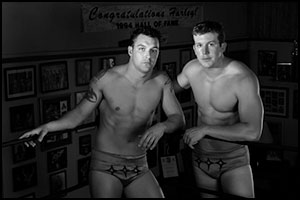by Stephen Von Slagle
Professional wrestling has always had more than its share of wild, larger-than-life ‘gimmick wrestlers’ or men who are known more for their ‘character’ than for their ability to perform inside of the ring. In many cases, the result has been embarrassing for both the wrestler and the sport. However, when the wrestler’s talent level is equal to the gimmick’s entertainment value, the result is almost always the emergence of a new wrestling superstar. And, without question, Ted Dibiase was one the most talented performers in wrestling during his nineteen years inside of the ring. The athletic second-generation grappler (both Dibiase’s father as well as his mother were professional wrestlers) burst onto the scene in the mid-Seventies and, almost immediately, he was pegged as a future NWA champion. Ultimately, he never wore the “ten pounds of gold.” However, with the aid of one of Vince McMahon’s greatest ideas, the former West Texas State lineman went on to transform himself into a character that will go down in the annals of wrestling history as one of the most successful and entertaining gimmicks ever; the cackling, money-grubbing, delightfully evil & sinfully wealthy Million Dollar Man.
The future Million Dollar Man was born on January 18, 1954, in Miami, Florida, the son of Ted Wills and Helen Nevins. His father was an entertainer and his mother built a career as a professional wrestler under the name Helen Hild. Hild competed during the Golden Age of Wrestling during the 1940s and 1950s and was a well-known attraction who wrestled against top-tier performers such as the renowned women’s World champion Mildred Burke as well as Burke’s successor, The Fabulous Moolah. Although his mother was a major professional wrestler, the story of The Million Dollar Man actually begins with another man by the name of Dibiase; “Iron” Mike Dibiase.
After splitting up with Ted Wills, Helen Nevins married Dibiase, who then adopted her young son as his own. For nearly two decades, “Iron” Mike was a popular fan favorite and a frequent champion during the middle portion of the twentieth century. A former national amateur champion at the University of Nebraska, the elder Dibiase also wore a version of the World Junior Heavyweight championship (precursor to today’s Cruiserweight or Light Heavyweight titles) and was well known by wrestling fans across the country. However, tragedy would strike the Dibiase family on a hot summer night in Lubbock, Texas. On July 2, 1969, the healthy, perpetually physically fit “Iron” Mike suffered a heart attack while performing a match and, tragically, died in the ring.
Ted Dibiase was just fifteen years old when his father passed away and, understandably, the death was a major blow to his family. But, despite the devastating loss of his dad, life went on and Dibiase attended high school at Creighton Prep in Omaha, Nebraska before going to West Texas State University on a football scholarship. However, due to an injury he suffered during his senior year, Dibiase made the decision to follow in his adoptive father’s footsteps and entered the wrestling business in 1974. An athlete of great natural ability, the 6’3″ 250 lb. Dibiase was trained initially by the Funk brothers and quickly graduated to the territorial circuit of the day.
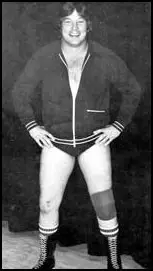 After learning the fundamentals in Texas, Dibiase began his career in the heartland of the country, wrestling for Bob Geigel’s Central States promotion and Sam Muchnick’s popular St. Louis-based group. Success came early for the young fan favorite and he soon won his first title, the Central States Heavyweight championship, from Drill Instructor Bob Slaughter (the future Sgt. Slaughter) on July 19, 1977. Dibiase scored another Central States title in January of 1978, and followed that win by also capturing the prestigious Missouri Heavyweight championship (often known as the ‘stepping stone to the NWA title’) a month later. It was as the Missouri champion that Dibiase began getting his first national write-ups in the wrestling magazines and the handsome young babyface quickly found himself in high demand across the country.
After learning the fundamentals in Texas, Dibiase began his career in the heartland of the country, wrestling for Bob Geigel’s Central States promotion and Sam Muchnick’s popular St. Louis-based group. Success came early for the young fan favorite and he soon won his first title, the Central States Heavyweight championship, from Drill Instructor Bob Slaughter (the future Sgt. Slaughter) on July 19, 1977. Dibiase scored another Central States title in January of 1978, and followed that win by also capturing the prestigious Missouri Heavyweight championship (often known as the ‘stepping stone to the NWA title’) a month later. It was as the Missouri champion that Dibiase began getting his first national write-ups in the wrestling magazines and the handsome young babyface quickly found himself in high demand across the country.
In 1979, just five years after entering the business, Dibiase was contacted by Vince McMahon, Sr. and brought into the World Wrestling Federation as the inaugural WWF North American champion. However, a few months after debuting his new championship, it came to McMahon’s attention that another North American title already existed in Bill Watts’ Mid South territory. With the wrestling business being what it was at that time, McMahon respectfully withdrew his “new” version of the North American title. Around this same time period, Pat Patterson defeated the young WWF North American champion for the title. Patterson then went on to enter his title into a “tournament” that was being held in Rio De Janeiro to determine the first Intercontinental champion. By virtue of his recent title win over Dibiase, Patterson represented North America and, in one of the biggest upsets in history, “won” the fictional tournament. Thus, the WWF I-C belt was born, while the short-lived WWF North American belt was forever buried.
It was also during this, his first WWF tenure, that Dibiase met and was defeated by a gargantuan young heel by the name of “The Incredible” Hulk Hogan in Hogan’s 1979 Madison Square Garden debut. While, at 6’3″ and weighing in at just under 250 pounds, Dibiase was big enough to handle himself against super-heavyweights, he was very much a scientific wrestler who relied on finesse and a solid repertoire of moves, not brute power. After gaining some seasoning in the Northeast, Dibiase traveled to the rugged Mid-South territory and once again became a North American champion, this time for promoter Bill Watts. After a successful run in Mid-South, Dibiase returned to Missouri and again captured the state’s Heavyweight title when he defeated Olympic weightlifter Ken Patera on November 21, 1980.
The national spotlight of TBS’s Georgia Championship Wrestling was next up for Dibiase and by this time he was a full-fledged superstar, one of the hottest young babyfaces the NWA had at the time, and slowly-but-surely he was being groomed to defeat Harley Race to become the new NWA champion. A controversial and very successful heel turn, first in Mid-South and a few months later in Georgia, proved that Dibiase could fulfill another requirement of any NWA World champion and truly work ‘both sides of the fence.’ However, due to a number of political factors and some plain old bad timing, Dibiase was never allowed to defeat Race for the NWA strap.
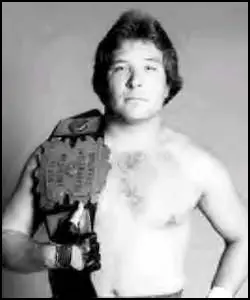 Ted Dibiase spent the first half of the Eighties traveling primarily between the Georgia, Missouri, and Mid-South territories, winning titles everywhere he stopped. Dibiase’s championship resume at this time included two National Tag Team championships and two National Heavyweight title reigns in Georgia, five Mid-South Tag Team titles and four North American Heavyweight titles in the Mid-South territory and two Missouri Heavyweight championships. He also forged a successful career in Japan wrestling for Shohei Baba’s All Japan Pro Wrestling, where he won the NWA United National championship as well as the PWF Tag Team title with partner Stan Hansen.
Ted Dibiase spent the first half of the Eighties traveling primarily between the Georgia, Missouri, and Mid-South territories, winning titles everywhere he stopped. Dibiase’s championship resume at this time included two National Tag Team championships and two National Heavyweight title reigns in Georgia, five Mid-South Tag Team titles and four North American Heavyweight titles in the Mid-South territory and two Missouri Heavyweight championships. He also forged a successful career in Japan wrestling for Shohei Baba’s All Japan Pro Wrestling, where he won the NWA United National championship as well as the PWF Tag Team title with partner Stan Hansen.
Although he’d been one of the most successful villains in the business, Dibiase eventually returned to the role of a babyface and with his lengthy heel turn long forgiven by his fans, he once again became one of the most popular fan favorites in the sport. Eventually, with the WWF’s expansion in full effect, Dibiase settled on Mid-South as his full-time base of operations. In order to compete with the ever-invading WWF, as well as Jim Crockett’s NWA group, Mid-South became the UWF, the Universal Wrestling Federation. Known for hard-hitting, non-stop action, the UWF set up a national syndication package and the regional group was eventually seen by wrestling fans nationwide.
The UWF, led by top babyfaces such as Dibiase, Steve Williams and Jim Duggan, as well as a roster of some of the best heels in the business at the time, quickly became known as the toughest promotion in wrestling, both on camera and off. However, when the UWF was eventually sold to Jim Crockett Promotions, Dibiase was lured away from another tenure with the NWA by an offer from Vince McMahon to enter the WWF with one of the promoter’s greatest gimmicks ever.
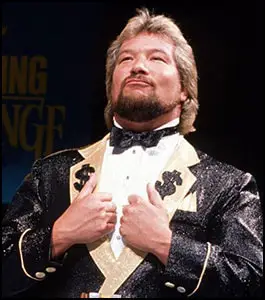 As the snickering, egotistical and downright evil Million Dollar Man, Dibiase quickly established himself as the Federation’s #1 ‘bad guy’ and WWF champion Hulk Hogan’s chief rival. Still one of the greatest scientific wrestlers to be found, Dibiase now had another ace up his sleeve; the fact that ‘everyone has a price’ and that The Million Dollar had the money to buy, literally, anything he wanted. Some of the WWF’s most entertaining vignettes involved Dibiase, whose character truly had a passion for humiliating and degrading ordinary people with his untold riches and bottomless savings account. With his silent, imposing bodyguard Virgil always by his side, Dibiase not only embraced being the wrestler that fans loved to hate but he also excelled at it, transforming himself into the quintessential pro wrestling heel.
As the snickering, egotistical and downright evil Million Dollar Man, Dibiase quickly established himself as the Federation’s #1 ‘bad guy’ and WWF champion Hulk Hogan’s chief rival. Still one of the greatest scientific wrestlers to be found, Dibiase now had another ace up his sleeve; the fact that ‘everyone has a price’ and that The Million Dollar had the money to buy, literally, anything he wanted. Some of the WWF’s most entertaining vignettes involved Dibiase, whose character truly had a passion for humiliating and degrading ordinary people with his untold riches and bottomless savings account. With his silent, imposing bodyguard Virgil always by his side, Dibiase not only embraced being the wrestler that fans loved to hate but he also excelled at it, transforming himself into the quintessential pro wrestling heel.
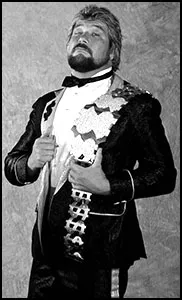 However, it was on February 5, 1988 that the legend of The Million Dollar Man was (arguably) born. On that evening, a national audience of over 33 million people tuned in to NBC (the first time one of the major networks had aired a pro wrestling event in nearly forty years) to see the WrestleMania III rematch of Hulk Hogan vs. Andre the Giant. Prior to the epic encounter, Dibiase had flatly stated on WWF programming that it didn’t matter who came out on top between Andre and The Hulk because he intended on simply buying the prized Heavyweight championship. After all, everyone has a price for the Million Dollar Man. History has since proven that what then took place was one of the most brilliant wrestling angles in the annals of professional wrestling. Twin referees, a bogus pin, the World Title wrongly changing hands — twice — and some of the most entertaining pro wrestling storytelling the world had ever seen. When “evil twin” ref Dave Hebner cost Hogan his belt, ending The Hulkster’s four-year-long first WWF title reign, with Dibiase then immediately trading Andre (and his manager, Bobby “The Brain” Heenan) a briefcase full of cash for the WWF strap, the fans in attendance, as well as those watching at home, were enraged.
However, it was on February 5, 1988 that the legend of The Million Dollar Man was (arguably) born. On that evening, a national audience of over 33 million people tuned in to NBC (the first time one of the major networks had aired a pro wrestling event in nearly forty years) to see the WrestleMania III rematch of Hulk Hogan vs. Andre the Giant. Prior to the epic encounter, Dibiase had flatly stated on WWF programming that it didn’t matter who came out on top between Andre and The Hulk because he intended on simply buying the prized Heavyweight championship. After all, everyone has a price for the Million Dollar Man. History has since proven that what then took place was one of the most brilliant wrestling angles in the annals of professional wrestling. Twin referees, a bogus pin, the World Title wrongly changing hands — twice — and some of the most entertaining pro wrestling storytelling the world had ever seen. When “evil twin” ref Dave Hebner cost Hogan his belt, ending The Hulkster’s four-year-long first WWF title reign, with Dibiase then immediately trading Andre (and his manager, Bobby “The Brain” Heenan) a briefcase full of cash for the WWF strap, the fans in attendance, as well as those watching at home, were enraged.
For a percentage of the wrestling fanbase, their anger stemmed from the fact that the highly theatrical spectacle was yet another example of how wrestling purists of the day felt Vince McMahon’s WWF was destroying the “sport” and turning it into a cartoonish circus. However, far more importantly, a much larger percentage of people were completely captivated by the shenanigans of Dibiase & Co. The debut episode of Saturday Night’s Main Event drew a huge rating for the WWF and NBC, easily eclipsing that of Saturday Night Live, which normally aired in S.N.M.E.’s time slot and was still one of NBC’s top programs at the time. Following the success of the debut episode, S.N.M.E. was a hit for the WWF & NBC for several more years to come, including another (highly rated) edition that featured Dibiase squaring off against Hogan one-on-one for the WWF championship.
Although it appeared that the impossible had truly happened and that Dibiase had, indeed, bought the Heavyweight title, the WWF refused to recognize his title claim, and the ramifications of that night on NBC led to WrestleMania IV, which featured a tournament for the held-up WWF championship. After defeating Jim Duggan and Don Muraco to advance to the finals of the tournament, Dibiase faced off against “Macho Man” Randy Savage and lost. Although fans of the day never knew it, Dibiase had actually been scheduled to win the WWF title against Savage, but, as had been the case in both the NWA and UWF previously, backstage politics ended up costing Dibiase his elusive World Title reign. Still, following his high-profile role in the main event of the inaugural S.N.M.E., The Million Dollar Man became a legitimate household name.
Over the following decade there were many twists & turns in the story of the Million Dollar Man, including a memorable run as the ‘Million Dollar Champion’ complete with his famously ostentatious diamond-studded title belt, as well as three WWF World Tag Team titles with fellow money-grubber Irwin R. Shyster. Even after the years and injuries finally took their toll and he was forced to retire in 1993, Dibiase still maintained a high profile and was an integral part of the World Wrestling Federation’s telecasts, both as the WWF’s top heel manager and, later, color commentator. But, as the WCW vs. WWF war began to heat up in the mid-Nineties, Dibiase, like so many other former WWF stars before him, eventually found his way to World Championship Wrestling and, more specifically, the promotion’s ultra-successful band of renegade heels known as the NWO, the New World Order.
With the arrival of “Trillionaire” Ted, the NWO’s new ‘financial advisor’, was further validation that the New World Order was, indeed, “taking over” and Dibiase was involved in several key WCW storylines during his three-year tenure with the Atlanta-based promotion. Eventually, though, he parted ways with the NWO, and became the babyface manager of multi-time NWA/WCW/WWF/New Japan World Tag Team champions Rick & Scott, the Steiner Brothers. After his run with The Steiners, Dibiase kept busy behind the scenes at WCW until he parted ways with the promotion in 1999.
 Following his retirement from wrestling, Dibiase vigorously pursued his new passion, that being religion. As a born-again Christian, Dibiase started his own ministry in 1999, founding the Heart of David Ministry and he began traveling across the country once again. This time, however, it was to churches and schools instead of sold-out wrestling arenas. And despite his strong personal beliefs, which often clashed with his former vocation, Dibiase found ways to occasionally return to his first love, most notable of which was his run as the color commentator for the short-lived, family-orientated W.X.O. syndicated wrestling program.
Following his retirement from wrestling, Dibiase vigorously pursued his new passion, that being religion. As a born-again Christian, Dibiase started his own ministry in 1999, founding the Heart of David Ministry and he began traveling across the country once again. This time, however, it was to churches and schools instead of sold-out wrestling arenas. And despite his strong personal beliefs, which often clashed with his former vocation, Dibiase found ways to occasionally return to his first love, most notable of which was his run as the color commentator for the short-lived, family-orientated W.X.O. syndicated wrestling program.
Then, in 2004, WWE offered DiBiase a job on their creative committee, where he spent the following year and a half helping to develop matches and storylines for WWE telecasts. Later, Dibiase was hired as a road agent for the Smackdown brand. In 2008, he introduced his talented son, Ted Dibiase, Jr., to the WWE audience and he was also involved in the wrestling careers of his two other sons, Mike and Brett Dibiase.
 In September of 1997, while he was working for WCW, Dibiase released his autobiography, Every Man Has His Price, through Multnomah Publishers. After returning to WWE in 2004, the promotion re-released an updated version of the book on June 10, 2008. In the years since his return to WWE, Dibiase has been a reoccurring special guest on various programs and network specials, where he appeared both as himself and in-character as The Million Dollar Man.
In September of 1997, while he was working for WCW, Dibiase released his autobiography, Every Man Has His Price, through Multnomah Publishers. After returning to WWE in 2004, the promotion re-released an updated version of the book on June 10, 2008. In the years since his return to WWE, Dibiase has been a reoccurring special guest on various programs and network specials, where he appeared both as himself and in-character as The Million Dollar Man.
Ted Dibiase is a member of the Wrestling Observer Newsletter Hall of Fame (1996), the Professional Wrestling Hall of Fame (2007), the International Wrestling Institute & Museum’s George Tragos/Lou Thesz Professional Wrestling Hall of Fame (2007), the WWE Hall of Fame (2010), and the St. Louis Wrestling Hall of Fame (2014).
